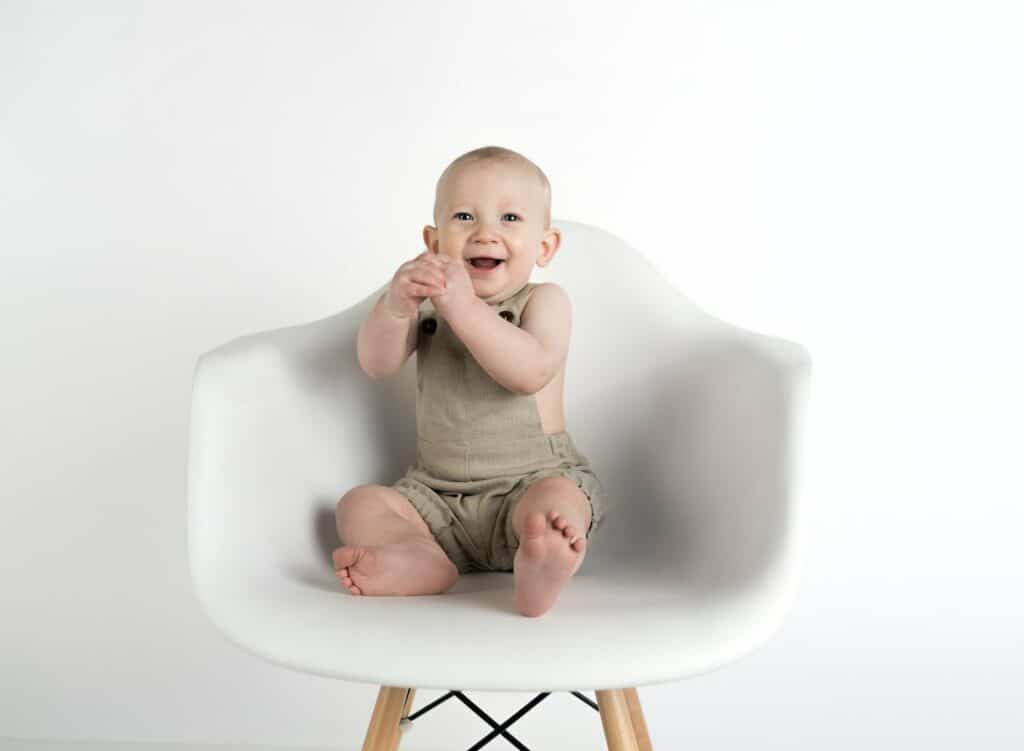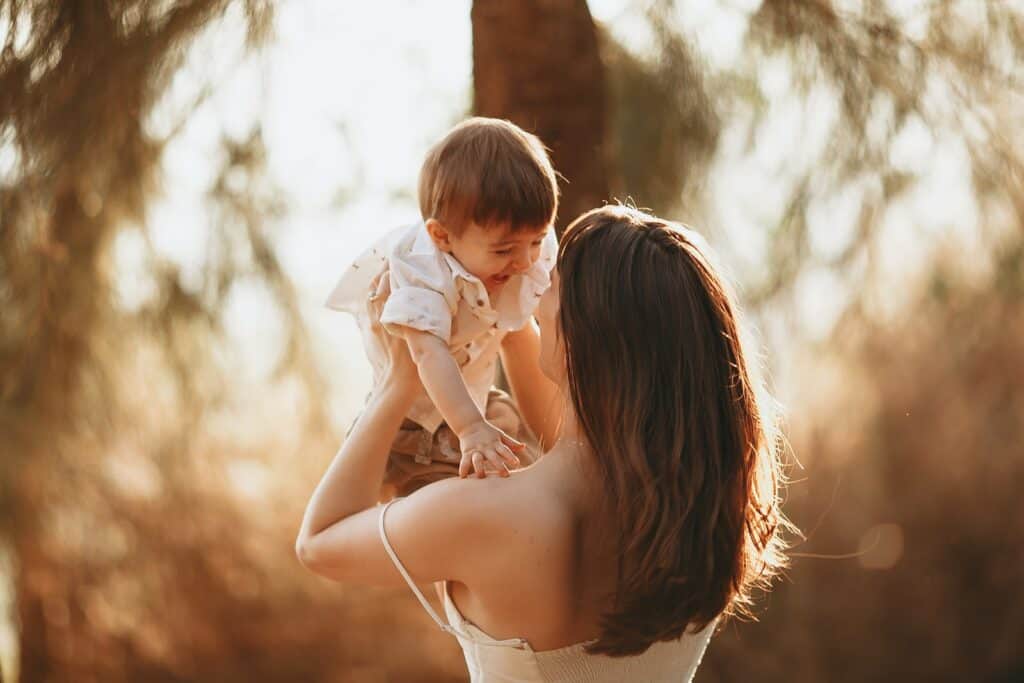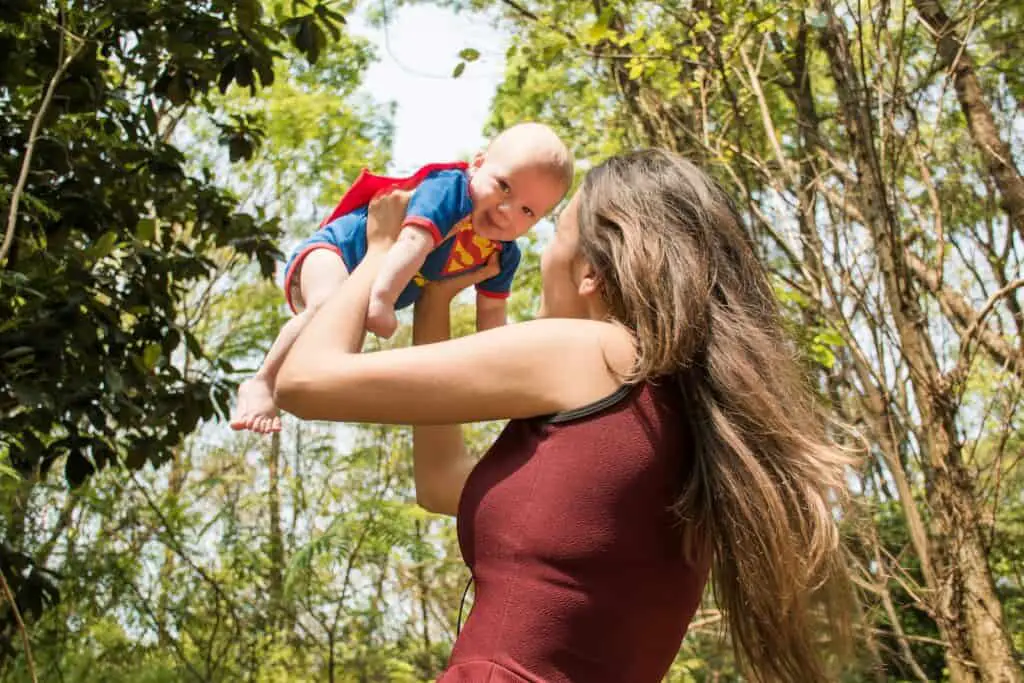As a parent, there’s nothing quite as delightful as making your baby laugh. The sound of a baby laugh can brighten even the gloomiest of days and create precious memories. In general, babies start laughing around the age of 3 to 4 months, although it can vary from one little one to another.
Encouraging laughter in your baby can be as simple as making funny faces, playing gentle games like pat-a-cake, or engaging in a lively round of peek-a-boo. If you find yourself wondering when your baby will start laughing, just remember that laughter and smiles will come as your baby develops and becomes more aware of their surroundings.
Babies love to mimic the actions of those around them, so by laughing and smiling yourself, you’re setting the stage for your baby to follow suit. So go ahead and get creative with your funny faces and silly noises – your baby’s laughter is just around the corner!
Understanding a Baby’s Sense of Humor

As a parent or caregiver, you might wonder how to make a baby laugh and understand their sense of humor. It’s important to know that babies start laughing at different stages but typically, it begins around 3-4 months of age. You can try various approaches to make your baby laugh and brighten their day.
One of the easiest ways to elicit laughter is by making funny faces. Babies love to watch expressions change, so be as animated as possible to get that adorable baby giggle. Playing interactive games like peek-a-boo and pat-a-cake can also make babies laugh, as these activities stimulate their developing social skills. Don’t forget to use funny noises and sounds to add extra fun.
There are a few physical games you can try to encourage your child’s laughter. Some popular ones include:
- Tickling their baby’s belly
- Blowing raspberries on their skin
- Gently blowing on their face
Eskimo kisses and a round of ‘This Little Piggy’ are other favorites for making babies laugh.
Aside from attempting to make your baby laugh, it’s crucial to monitor their laughter development. Pay attention to when babies start laughing, as it might indicate their overall development progress. If your friend’s child is laughing at four months but yours isn’t, don’t panic. Every child is unique, and many factors can affect the age at which children start laughing. In some cases, a delay in laughing might signal developmental issues, so it’s always wise to consult with a baby’s doctor to make sure everything is on track.
It’s important to remember that babies develop at their own pace. While some might find enjoyment in physical games, others might love the sound of silly voices and odd noises. So, be patient and keep experimenting to find what makes your baby laugh the most.
One excellent technique to engage older children and encourage a baby’s laughter is to play peek-a-boo. This game teaches babies object permanence – the concept that objects (and people) still exist even when they’re out of sight. The surprise element of this game can elicit delightful giggles.
Bonding with your baby through laughter is not only entertaining but also helps them develop crucial social skills. Their first giggle or chuckle is a memorable experience, and understanding their sense of humor is essential to ensure their happiness and well-being. So, don’t be afraid to get creative and have fun exploring different ways to make your baby laugh.
Using Sound and Movement to Entertain

As a parent, we often wonder how to make a baby laugh, and delight in their little giggles. Babies start laughing around the age of 3-4 months, but it’s important to remember that every baby is different and may develop at different rates. In this section, I’ll give you some tips on how to use sound and movement to make your baby laugh. Remember, laughter is essential for a baby’s development, so have fun during your comedy hour!
One of the most popular ways to make a baby laugh is by making funny faces and playing physical games such as peek-a-boo and pat-a-cake. These age-old games never fail to amuse a baby, especially when they involve exaggerated facial expressions and movements. Playing peek-a-boo helps babies understand object permanence, while pat-a-cake promotes hand-eye coordination.
Babies love a variety of sounds. We can make them giggle by producing funny noises such as blowing raspberries on their belly or making odd sounds with our mouths. Experiment with various funny sounds and observe which ones make them laugh the most. Another great idea is to sing nursery rhymes like “Itsy Bitsy Spider” and “This Little Piggy,” complete with finger movements and tickles.
Here are some additional techniques to help you make your baby laugh:
- Eskimo kisses: Lightly rub your nose against your baby’s, creating a gentle tickling sensation. This can often elicit laughter and smiles.
- Laughter is contagious: Many babies find grown-up laughter hilarious. So don’t hesitate to laugh alongside your little one when they start laughing or giggle at something funny.
- Tickle monster: Create a tickle monster persona with your hands and a silly face. Gently tickle your baby’s skin as you approach them with your tickle monster character, making them giggle in anticipation.
If you’re ever with a friend’s child, you can use these techniques to make their baby laugh as well. However, keep in mind that not every baby may respond to the same tools. In case a baby doesn’t laugh, consider speaking with the baby’s doctor as sometimes a developmental delay or other communication disorders could be a possible reason.
To finalize, always keep in mind that making a baby laugh isn’t an exact science, and it might take some trial and error. But it’s important to have fun, and enjoy the process. As your baby finds joy in the most basic actions, you’ll find that your bond deepens while helping them develop essential social skills. Happy laughing!
Engaging in Interactive Play

Discovering how to make a baby laugh can be a delightful experience for parents, caretakers, and friends alike. Babies typically start laughing around the age of 3-4 months. Since babies’ laughter varies, I’ll provide you with several interactive play ideas to bring out the giggles.
One universal way to make babies laugh is playing peek-a-boo. Many babies love the surprise of seeing your face disappear and reappear. Playing peek-a-boo is effective in eliciting laughter because it helps babies develop their understanding of object permanence.
Another classic game is pat-a-cake. Sing the nursery rhyme while clapping your hands and gently touching the baby’s belly or hands. It’s an entertaining way to make your baby laugh and get them engaged in playtime.
Funny faces and sounds are a tried-and-true method to get babies laughing. Here are a few to try:
- Stick your tongue out
- Puff your cheeks
- Raise your eyebrows
- Make exaggerated expressions of surprise, happiness, or sadness
Don’t be afraid to experiment and find out what specifically makes your little one laugh. Odd sounds like blowing raspberries or making silly animal noises could send your baby into a fit of giggles.
Physical games are a great way to have fun with your little one. Eskimo kisses – rubbing your nose against the baby’s – can bring on precious little giggles. This little piggy is another classic game beloved by many babies- simply wiggle their toes while reciting the familiar rhyme. Lastly, become a tickle monster! Gently tickle your baby’s skin, on their belly, feet, or other areas to get the laughter flowing.
You may find that many babies react differently to various forms of play. Since babies are individuals, they may find different things tickle their funny bone. Utilize these suggestions as a starting point and observe what works best for your child. Before you know it, you’ll be an expert in knowing how to make a baby laugh.
The Power of Facial Expressions and Silly Faces

As a parent, figuring out how to make a baby laugh can be both a fun and rewarding experience. When it comes to eliciting laughter in little ones, I’ve found that facial expressions and silly faces are incredibly effective. In this section, I’ll share some tips and tricks on how to make your baby laugh using the power of funny faces.
Between the ages of 3 and 4 months, many babies start laughing and this can be a heartwarming milestone for parents. It’s crucial to understand that each baby is unique, and while some may laugh earlier, others might take a little longer to start laughing. Some popular facial expressions and games that tend to make babies laugh include:
- Peek-a-boo: Babies love this classic game, as it helps them develop an understanding of object permanence. To play peek-a-boo, simply hide your face behind your hands, and then quickly reveal it while saying “peek-a-boo!” The surprise element and your funny face will likely make your baby giggle.
- Pat-a-cake: It’s a fun game for babies as you gently clap their hands together while reciting the familiar rhyme. Make silly faces and use exaggerated expressions to make your baby laugh even more.
- Eskimo Kisses: Gently rub your nose against your baby’s and make a funny sound. The sensation and your silly expression can often cause those little giggles to burst forth.
- Blowing Raspberries: Gently blow raspberries on your baby’s belly or cheeks, and watch as their laughter fills the room. This is a great way to bond with your little one and tickle their funny bone.
Remember that repetition is key when it comes to making your baby laugh. Little ones enjoy the predictability and routine of specific actions, sounds, or expressions, so don’t be afraid to repeat your silly faces and funny noises to keep the laughter going.
It’s also important to be responsive to your baby’s reactions. If they don’t find a certain facial expression or sound amusing, try something different. Experimenting with various expressions and sounds can help you discover what truly tickles your baby’s funny bone.
Engaging with other children, such as older siblings or a friend’s child, can also encourage your baby’s laughter. As babies start to develop social skills and understand humor, watching other children laugh can trigger their own laughter.
It’s important to note that laughter is not only a joyful bonding experience, but it also plays a critical role in your baby’s overall development. Laughter can help with their emotional growth, communication skills, and cognitive development. As babies start laughing, they are learning to respond to their environment, mirror emotions, and comprehend interactions.
So go ahead, pull those funny faces and make silly noises, because making your baby laugh is truly a priceless gift that benefits both of you.
Final Thoughts on Making Babies Laugh
Throughout this article, we’ve explored various ways to make a baby laugh. As parents or caregivers, we cherish those little giggles and laughter from our tiny tots. It’s essential to remember that babies may start laughing at different ages, but most babies will begin to chuckle between the ages of 3 to 4 months.
Some of the best ways to make your baby laugh include:
- Playing peek-a-boo
- Making funny faces and noises
- Singing songs, like Itsy Bitsy Spider or Pat-a-Cake
- Blowing raspberries on their belly
- Engaging in physical games or tickling
Babies love the interaction and attention, and many babies will giggle in response to your silly faces and funny noises.
When you play peek-a-boo or similar games, you’re helping your baby develop an understanding of object permanence. As babies learn that something can reappear after disappearing, they find it amusing and laugh out loud.
While it’s a delightful experience to make your baby laugh, be mindful of overstimulating them. If they seem disinterested or fussy, it might be a cue to give them a break and try again later. Remember, every baby is unique, and what makes one baby giggle might not work for another. Experiment with different techniques and activities to find what tickles your little one’s funny bone.
In conclusion, it’s essential to appreciate and enjoy the laughter of your little one. Baby laughs not only bring joy to our lives but also help them develop their social skills and understanding of humor. So keep trying new ways to elicit laughter, and relish every precious giggle.
Other suggested articles:
- How Acts Of Kindness Can Transform The World
- How Can Gratitude Change Your Mindset
- How Can Gratitude Improve Mental Health
- How Can Gratitude Turn A Negative Into A Positive
- How Can Technology Help Wellness
- How Can You Show Gratitude To Your Parents
- How Cutting Down On Car Usage Can Help Save Our Planet
- How Does Gratitude Affect Relationships
- How Indoor Plants Can Help With Mental And Emotional Health
- How Is Happiness Different From Joy
- How Much Of Happiness Is Genetic
- How Pets Can Enhance Our Happiness
- How Photography Can Help Cultivate Mindfulness And Gratitude
- How To Apologize For Calling Someone The Wrong Name
- How To Apologize For Sending Too Many Texts
- How To Apologize For Sending Wrong Text
- How To Apologize To A Guy You Like Over Text
- How To Apologize To An Old Friend
- How To Avoid Procrastination And Laziness
- How To Be Able To Laugh At Yourself
- How To Be Happier At Work
- How To Change Your Luck
- How To Create Your Own Happiness
- How To Define Happiness
- How To Easily Make Someone Laugh
- How To Improve Your Social Life
- How To Laugh More In A Relationship
- How To Laugh Off Embarrassing Situations
- How To Learn To Laugh More
- How To Live In The Moment
- How To Make A Baby Laugh
- How To Make A Person Happy
- How To Manifest Happiness
- How To Minimalize Your Life
- How To Motivate Yourself
- How To Never Have To Work Again
- How To Overcome Envy
- How To Overcome Nervousness
- How To Reduce Anxiety Quickly
- How To Show Happiness In Writing
- How To Stop Being Pessimistic
- How To Stop Feeling Nostalgic
- How To Stop Feeling Sorry For Yourself
- How To Tell Someone They Are Amazing
- How Travel Can Expand Your Happiness Horizons

